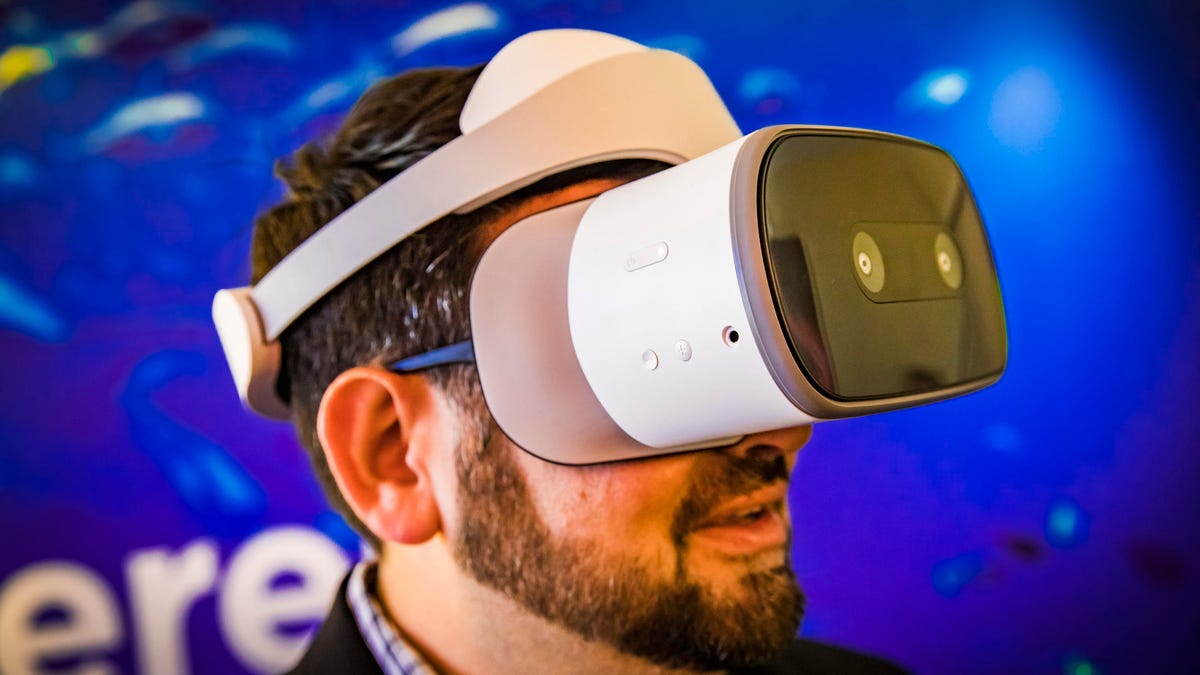At CES, VR and AR are evolving right under your nose
Don't expect wild new worlds: This year, it's small changes that matter.

Lenovo's new Google Daydream VR headset can work without a phone, and even let you walk a bit.
When VR first made its major CES reemergence via Oculus Rift years ago, it was jaw-dropping.
Those moments, since, are harder to come by. After a 2017 where VR hardware sales flagged and buzz quieted, AR started to gain steam via phone apps from Apple and Google . Meanwhile, the dream of some next-level "mixed reality" -- a holographic blend of the virtual and real -- hasn't gotten here. We have Hololens , and we wonder what Magic Leap will be, but no new things came from CES .
But there were discoveries, and trends, and things to talk about in AR and VR. You just had to pay attention.
HTC's new Vive Pro has upgraded display resolution and can be completely wireless from the PC, with a separate Intel WiGig adapter.
VR is getting better with key upgrades: wireless, better res, better cameras
Maybe virtual reality, as an industry, realizes that getting everyday people into headsets, not to mention buying them, isn't easy. Instead, HTC is pushing its Vive hardware into deeper enthusiast and enterprise territory. The HTC Vive Pro has higher-resolution displays, a comfier fit, a larger range of movement, and you can even cut the cord with a wireless Intel WiGig adapter that removes the tether to the PC.
The Vive Pro doesn't have a price, and it's not likely to be cheap. But it's driving VR forward with improved and much-needed tweaks that truly make a difference, and will eventually be in more affordable headsets, too.
Meanwhile, mobile headsets could get better tracking: Lenovo and Google's VR collaboration, the Mirage Solo, adds cameras that allow a bit of walking and movement like PC VR does. (More on that below.)
Problems in VR might be disappearing, too. It's still not possible to try VR games and really avoid tripping over furniture; cameras on VR headsets don't see the real world much yet. Occipital demoed a way to pass information about the real world into VR using stereo cameras on a headset. The room around me continued to be scanned in real time, providing a better awareness than Vive, Oculus, Microsoft and PlayStation VR currently allow. Maybe Occipital's VR/AR SLAM (simultaneous localization and mapping) system will find its way into future VR headsets, and make larger walk-around virtual-reality living room holodecks easier to navigate.
Lenovo's Mirage Solo headset works with Google Daydream without a phone, but still uses the same remote.
Phone-free mobile VR is coming, if you want it
Some virtual reality hardware requires consoles and PCs, but mobile VR needs a phone. That will change, soon, thanks to self-contained headsets with mobile processors inside. Google and Lenovo's Mirage Solo with Daydream headset is like the upcoming Oculus Go: both are gear you can instantly use without adding a phone. The Mirage Solo has another trick up its sleeve with limited camera-based positional tracking that allow you to lean in, duck or take a few steps in supported Google Daydream apps. These stand-alone mobile headsets could end up being popular in classrooms, for public VR screenings and experiences, and for anyone that doesn't already have a VR-ready top-end phone.
Vuzix Blade bakes Amazon Alexa into its Google Glass-like smartglasses.
Smartglasses + voice AI = ?
Google Glass feels like a million tech years ago. And yet there are still many smartglasses that are essentially the same thing: a monocular single display hovering in one eye, a built-in camera and no easy to control anything. Vuzix Blade is the first pair of smartglasses promising built-in Amazon Alexa for voice-controlling access to messages, connected devices and getting to info faster. I didn't get to demo how well Alexa performed with Vuzix Blade, but I'm skeptical. Chinese AI company Rokid is exploring a similar idea with Rokid Glass. Will voice assistants help AR? Right now it seems like an exploration, not a clear answer.
Pop a phone in: iPhone and Android AR toys that work with ARKit and ARCore, like Merge's 6DoF Blaster, might be the best bang for the buck.
While AR finds its way, maybe simple toys are the best bet
While augmented reality and mixed reality headsets still cost either hundreds or thousands of dollars -- or don't even exist yet (see Magic Leap) -- the safest path might be connected phone accessories that tap into Apple's ARKit and Google's ARCore. Merge's 6DoF Blaster is like a reinvented Laser Tag gun that plays games, and it could work with multiplayer and across iOS and Android. It was the smoothest-running AR demo I tried on the CES show floor.
Rokid Glass: Another assistant-in-smartglasses idea you'll probably never use.
The future's not here (yet)
Oculus' next-generation hardware is on the horizon. Magic Leap might have its hardware debut this year. Other surprises are undoubtedly in store. VR and AR are still in evolution. The next big step isn't here. But it feels like we're a half-step closer than before.
PC preview: What to expect from laptops , desktops and tablets at CES this year.
CES 2018: CNET's complete coverage of tech's biggest show.

